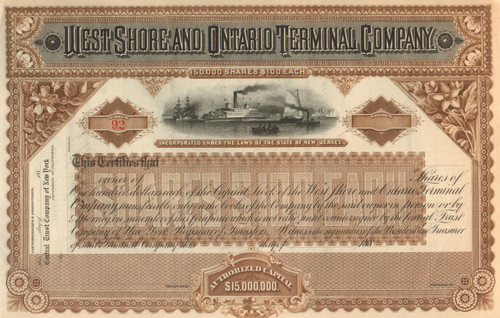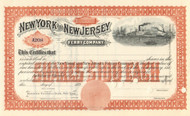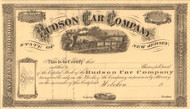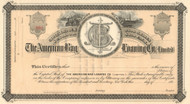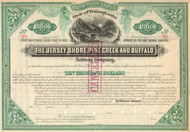Categories
Categories
West Shore and Ontario Terminal Company circa 1883 (New Jersey)
Product Description
West Shore and Ontario Terminal Company stock certificate circa 1883
Stunning vignette of steamships and sailing ships on a crowded river . Unissued and not cancelled. Circa 1883 from company records. Incorporated in New Jersey.
On July 9, 1901, the West Shore Railroad Company merged with itself the West Shore and Ontario Terminal Company, formed on June 20, 1883, as The Open Cut and General Storehouse Company (the name being changed on the same date) by consolidation of The National Stock Yard Company (incorporated March 16, 1869, supplemented February 23, 1870), The Midland Terminal and Ferry Company (incorporated by change of name March 7, 1873, from The Weehawken Transportation Company, incorporated March 22, 1871) and The Open Cut and General Storehouse Company (incorporated March 22, 1871, in the state of New Jersey as a reorganization after sale, on September 21, 1881, of The Weehawken Ferry Company, incorporated March 25, 1852, in the state of New Jersey).
The West Shore Railroad was the final name of a railroad from Weehawken, New Jersey, across the Hudson River from New York City, north along the west shore of the river to Albany, New York and then west to Buffalo. It was organized as a competitor to the New York Central and Hudson River Railroad, but was soon taken over by that company.
The first part of the line was built as the Saratoga and Hudson River Railroad, incorporated April 16, 1864 and opened in Spring 1866. After only about a year of independent operation, the line served as a branch of the New York Central Railroad (NYC), splitting at Athens Junction near Schenectady and running southeast and south along the west side of the Hudson River to Athens, New York. Early plans included acquiring the Saratoga and Schenectady Railroad as a northern extension. The Saratoga and Hudson River was bought and merged into the New York Central as their Athens Branch on September 9, 1867. The terminal at Athens was destroyed by fire in 1876. The line ran intermittently from then into the 1880s, with its tracks being torn up for good in 1888. It had been called the "White Elephant" Railroad for most of its existence because it quickly outlived whatever usefulness it may have had. Today a row of brick houses known as the Brick Row Historic District which was built in 1850 for the workers of the failed railroad stand in Athens as the only remaining structure related to the "White Elephant" Railroad project.
At the south end of the route, the Ridgefield Park Railroad was incorporated April 4, 1867. This was planned as a branch of the New Jersey Rail Road, splitting at Marion Junction and running north on the west side of the New Jersey Palisades via Ridgefield Park to the state line at Tappan, New York. Across the state line, the Rockland Central Railroad was incorporated May 23, 1870 to continue the line to Haverstraw, and the Rockland Central Extension Railroad, incorporated May 29, 1872, was to continue further north along the west side of the Hudson River. The Rockland Central and Rockland Central Extension merged on July 29, 1872 to form a new Rockland Central Railroad, and that company merged with the Ridgefield Park to form the Jersey City and Albany Railroad on June 24, 1873, with the intention of building a full line from Jersey City to Albany.
The line first opened in 1872 as a spur of the New Jersey Midland Railroad, which had built the section south of Ridgefield Park. At that time, the northern terminus was at Tappan; the extension north to Haverstraw, New York opened in 1879. Bankruptcy struck soon, and the New York section of the line was sold on September 28, 1877 and reorganized October 12, 1878 as the Jersey City and Albany Railway. The part in New Jersey was sold August 17, 1878 and reorganized with the same name, and the two companies merged in January 1879 to form a consolidated Jersey City and Albany Railway.
The North River Railway was incorporated April 3, 1880 to extend the line north to Albany with a branch to Schenectady and a connection to the New York, Ontario and Western Railway (O&W) at Cornwall, New York. The North River Railway was consolidated with the Jersey City and Albany on May 5, 1881 to form the North River Railroad, again forming a single planned line between Jersey City and Albany.
The Hudson River West Shore Railroad was incorporated February 16, 1867, and the West Shore Hudson River Railroad was incorporated October 28, 1867, absorbing the Hudson River West Shore on February 16, 1867. This was a second proposed line on the west shore of the river from New Jersey to Albany. The New York, West Shore and Chicago Railroad was incorporated July 13, 1870, and absorbed the West Shore Hudson River on July 21, 1877, with a planned line not only to Albany but then west along the south bank of the Mohawk River to Buffalo. That company was sold and reorganized as the New York, West Shore and Buffalo Railway on February 18, 1880, and on June 14, 1881 the North River Railroad was merged into it, forming one company in charge of the whole route from New Jersey to Buffalo.
In 1883, the newly formed company inaugurated service from Newburgh and Jersey City at the Pennsylvania Railroad Depot, where passengers transferred to ferries across the river. A new alignment was built along the east side of the New York, Susquehanna and Western Railway (formerly the New Jersey Midland) to North Bergen. By 1886, service operated to Weehawken Terminal through a tunnel under Bergen Hill that had been built in the three preceding years. The company leased the Athens Branch of the New York Central and Hudson River Railroad, the old Saratoga and Hudson River Railroad, and incorporated it into their main line between Coxsackie and Fullers. At Ravena, along the Athens Branch, the main line turned northwest towards Schenectady, while a new branch continued north to Kenwood Junction on the Albany and Susquehanna Railroad in Albany. This full line formed an immediate threat to the NYC monopoly.
In addition to its owned trackage, the West Shore (WS) also had trackage rights over the Suspension Bridge and Erie Junction Railroad and Erie International Railroad, providing a route from Buffalo to Ontario. After the New York Central took over the West Shore, this was useless, as the New York Central had a parallel line, the Buffalo and Niagara Falls Railroad. The West Shore also had relations with the Boston, Hoosac Tunnel and Western Railway (BHT&W), which would have run from the Hoosac Tunnel in Massachusetts west to Buffalo. Instead the BHT&W built only to Rotterdam Junction west of Schenectady; it was later taken over by the Fitchburg Railroad.
In 1881, the WS had been planned as a link in a new cross-country line from New York to San Francisco, using the Nickel Plate Road, Chicago, Milwaukee and St. Paul Railway, Northern Pacific Railroad and Oregon Navigation Company. However, William Henry Vanderbilt of the NYC had bought the Nickel Plate in 1882, killing that plan. The NYC then proceeded to drive the New York, West Shore and Buffalo into bankruptcy. The NYC bought the New York, West Shore and Buffalo Railway on November 24, 1885 and reorganized their new acquisition as the West Shore Railroad on December 5, leasing it for 475 years from January 1, 1886. In many sections, the WS ran on a straighter path than the NYC, and was thus used for through freight. For instance, between Oneida and Utica, the WS followed the general line of the never-built Syracuse and Utica Direct Railroad, which had been merged into the NYC.
 Loading... Please wait...
Loading... Please wait... 
